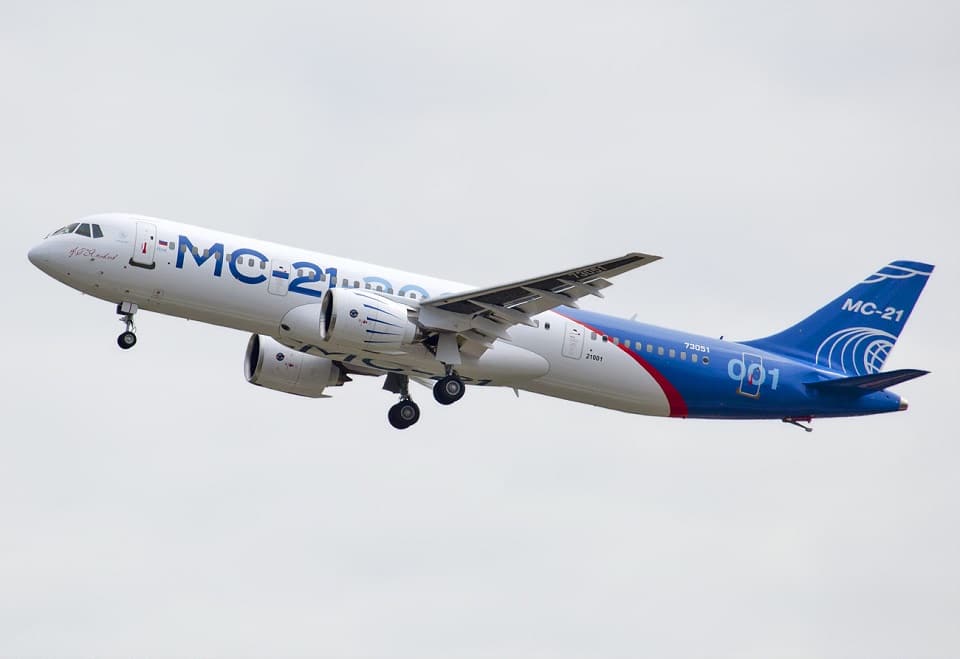Aviation
Is Russia’s dream of competing with Airbus and Boeing turning into a nightmare? Russian MC21 delay

The much-anticipated Russian competitor to Airbus A320neo and Boeing 737 MAX, the Yakovlev MC-21, is encountering yet another setback as its first deliveries are pushed back to 2025 or 2026.
Rostec CEO Sergei Chemezov disclosed the extended timeline, underscoring the ongoing challenges plaguing Russia’s aerospace industry.
Originally slated for delivery to the state-owned Aeroflot group in 2022, the MC-21’s schedule has been repeatedly pushed back, with 2024 being the subsequent target. However, amidst the aftermath of Russia’s involvement in Ukraine and ensuing international sanctions, the project has faced significant hurdles.
The conflict in Ukraine has triggered sanctions from the United States, European Union, and other Western nations, severely impeding Russia’s aerospace sector. Access to vital components and technology has been curtailed, impinging upon the MC-21’s development and production. The situation necessitated a shift away from reliance on foreign elements, with a focus on domestic alternatives to mitigate the impact of sanctions.
Initially hailed for its groundbreaking design featuring an innovative composite wing and reliance on foreign components like the Pratt & Whitney PW1400G engines, the MC-21 project has to adapt swiftly in the face of mounting challenges. The recent wave of sanctions has intensified the isolation of Russia’s aerospace sector, underscoring the pressing need for self-reliance in aircraft production.
Looking ahead, Rostec envisions a more optimistic trajectory, expressing its intent to ramp up production to 72 aircraft annually by the year 2029. Yet, achieving such aspirations hinges upon overcoming the multifaceted hurdles posed by ongoing sanctions and geopolitical tensions.

Aviation
Boeing, Antonov to Collaborate on Defense Projects

– MOU represents Boeing’s commitment to work with Ukrainian industry
– Includes exploring opportunities for collaborating on in-country support of Unmanned Aerial Systems
A Memorandum of Understanding was signed today by Boeing and Antonov Company to investigate potential collaboration on defense-related projects.
“We’re happy to keep collaborating with the Antonov Company to help Ukraine’s economic development and expansion,” stated Ted Colbert, CEO and president of Boeing Defence, Space, & Security.
Airbus and the Antonov An-225: The Best Partnership:Click here
“This agreement demonstrates our ongoing efforts to find more opportunities to work with Ukrainian industry, which was underscored by our signing of the Ukrainian Defence Industry Compact earlier this year.”
The areas of potential collaboration identified in the agreement consist of training, logistical support and overhaul services for tactical Unmanned Aerial Systems utilized by the Ukrainian Armed Forces, which includes the ScanEagle. In addition, the companies will also explore opportunities for Antonov to provide engineering support to Boeing.
The six largest cargo aircraft ever built in the aviation industry:Click here
“A strong, innovative, and efficient defense industry is key to sustainable economic development and national security, and we are extremely excited to collaborate with Boeing,” said Ievhen Gavrylov, CEO of Antonov Company.
This agreement brings a whole new level of opportunity to implement the latest and most effective solutions – in addition to the possibility of future projects with Boeing in the aerospace and defense industry.”
-

 Travel1 week ago
Travel1 week agoAir India to Expand US Operations with Three New Routes After a Decade
-

 Travel2 weeks ago
Travel2 weeks agoWhy We Should Avoid These Stamps in a Passport
-

 Airlines1 month ago
Airlines1 month agoInvestigations Reveal Fake Chinese Titanium in Boeing and Airbus Jets
-

 Tech4 weeks ago
Tech4 weeks agoChina’s CATL Plans 1,800-Mile Electric Plane Launch by 2027
-

 Airport3 days ago
Airport3 days agoTop 10 Largest Airports in the World by Size
-

 Aerospace4 weeks ago
Aerospace4 weeks agoChina’s Fighter Jets Turn Wings into Autonomous Drones
-

 Airlines4 days ago
Airlines4 days agoAir India Rolls Out A350s for Delhi-New York JFK and Newark Routes
-

 Defence3 weeks ago
Defence3 weeks agoBoeing Enhances Chinook with New Engines and Block II Upgrades at $96 Million







